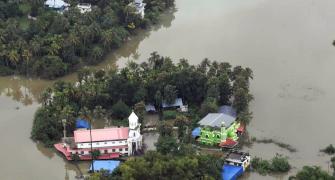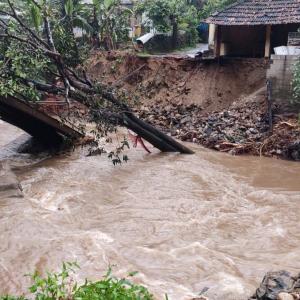'Cinema or the sentiment of a people, disgusted by contemporary politics and wanting to feel whole by collectively recalling a moment of great difficulty that was also a cause for togetherness?', asks Shyam G Menon.

Sometimes one asks after a film seen: Why did I watch it?
For me, the answer as regards the hit Malayalam film 2018, was simple.
In Thiruvananthapuram, and wishing to see a film in a theatre, my friend and I were absolutely certain that The Kerala Story wasn't our cup of tea.
Neither of us wished to tumble down the rabbit hole of imagination associated with the film's subject. To its credit, Kerala didn't ban the movie.
Being able to watch what one wants to, is an important freedom to preserve.
Same time, almost in proportion to how much that film hurt some people's picture of Kerala, the film 2018 was finding traction and well on its way to be a box office hit.
The film had good reviews. Some called it the real Kerala story. That's how we ended up watching 2018.

The deadly flood of August 2018 was the biggest natural weather phenomenon to hit Kerala in recent years.
It was a monster; a case of heavy rainfall already underway with dams hosting increased water levels, atop which, came a particularly strong spate of rain.
Just how important the rain was in shaping memory around the 2018 flood may be understood from this fact -- for many people in Kerala, there is a pre-2018 affection for rain (an innocence attached to it) and a post-2018 worry (bordering fear) about rain.
In other words, there cannot be a character more central to the floods of 2018 than the rain and the unusual manner in which, it poured.
The setting gets richer (from a cinematic perspective) if you factor in climate change and it's still inadequately understood impact on Kerala and life / lifestyle there.

Roughly three months before the floods of 2018, Kerala had been hit by an outbreak of the deadly nipah virus.
In 2019, this medical emergency became the subject of a film called Virus.
To my mind, Virus was a remarkable film; one that didn't go overboard in how it narrated its story.
It based itself on real life incidents and ran a tight ship of a script.
The contagious nature of the infection and the deadliness of the condition that the nipah virus caused, sufficed to infuse its frames with tension and bring to life the crisis.
As for acting, there was no resort to smart aleck styles of portrayal, no caricaturing as short cut to establish character.
The floods of August 2018 affected more people than the nipah virus outbreak did. Yet as the sum total of different incidents, which films on crises usually tend to be, Virus did a better job.
It held itself together stronger and converged more effectively. Why didn't 2018 work similarly for me?

My guess is the film was limited by what it set out to portray as conveyed in its tag line: everyone is a hero.
If one adopts an intended outcome as guiding light, one runs the danger of viewing the subject through its prism. That is precisely what I felt about 2018 the film.
Notwithstanding crisis building up over a few days and reaching breaking point, in the film, the unusual rainfall wasn't a star.
It stayed a faceless supporting actor devoid of introduction, meteorology and investigation.
There was no deep dive into the quandary of managing dams amid heavy rains or an overview of Kerala's geography -- an intensely packaged composite of high hills, rivers, backwaters and estuarine regions -- either.
A simple way of comprehending the divergent templates of Virus and 2018, lay in the characters portrayed by an actor featured in both the movies-- Kunchacko Boban.
His Dr Suresh Rajan from Virus was important as medium explaining the architecture of a nipah outbreak.
In 2018, a film devoid of such mediums, the character he portrays (Shaji Punnoose) remained part of the cast.

Instead of helping me comprehend the floods, 2018's script wanted me to remember heroic humans; probably because the goal was to inform that everyone is a hero.
Freed of that compulsion, I think 2018 would have been a less melodramatic, more realistic and more watchable film.
I sat in the theatre hoping to understand better a freak weather phenomenon, its onset in Kerala, what the authorities made of it, the crisis it caused and in the addressing of which, heroes were born.
In the end, I was left disappointed in terms of cinema although I was happy that the state had a film about everyone being heroes just when the politics of polarisation was attempting its best to sully Kerala's self-image.
But even here, some of the heroes manifested abruptly. For instance, during my regular calls from Mumbai, my late mother, who lived in Kerala and followed the floods closely, had mentioned how heartwarming it was to see the state's youngsters respond to the crisis.
In the film, such instances happen snappishly as the product of fast communication in digital age with little explored by way of what made young people respond so.

There was also another aspect. Not long after it started, the film felt loud. It was a loudness different from merely volume being high; it harked of a lack of discerning separation in the film itself, between sounds critical for the story and the background score.
How one uses background score in films dealing with tense subjects, calamity and crisis, is a delicate art. By its very nature, calamity and crisis is edgy stuff.
When a film-maker augments already existing tension and emotion (naturally generated by the subject) with music, he has to be careful not to author sensory overload.
That balance appeared upset in 2018 with its auditory stimuli (an essential part of any movie) in constant overdrive.
At several points, one wished that the sound track had been a fully natural one -- just the sound of rain, perhaps?

On May 28, 2023, onmanorama.com reported that 2018 had become the highest grossing Malayalam film to date. So, what worked for it?
Cinema or the sentiment of a people, disgusted by contemporary politics and wanting to feel whole by collectively recalling a moment of great difficulty that was also a cause for togetherness?
I think it's a bit of both, but certainly a mix that includes the latter.
Shyam G Menon is a freelance journalist based in Mumbai.
Feature Presentation: Ashish Narsale/Rediff.com









